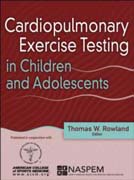
Exercise testing plays an increasingly important role in the diagnosis and assessment of heart disease and lung disease in children and adolescents. In Cardiopulmonary Exercise Testing in Children and Adolescents, leading expert Thomas W. Rowland, backed by the American College of Sports Medicine (ACSM) and the North American Society for Pediatric Exercise Medicine (NASPEM), compiles the latest evidence-based research to provide guidance for clinical exercise physiologists, cardiologists, pulmonologists, and students of exercise physiology who conduct exercise stress testing for young patients. The core objective of the book is to clarify the differences between clinical exercise testing for children and testing for adults. Because of obvious differences between the two populations, test protocols must be modified based on the patient’s age, size, level of physical fitness, body composition, intellectual and emotional maturity, and state of cardiac and pulmonary health. Part I provides an introduction to pediatric exercise testing. Part II examines exercise testing methodologies and discusses blood pressure, cardiac output, electrocardiography, oxygen uptake, and pulmonary function. Part III focuses on specific clinical issues addressed by exercise testing, guiding readers through protocols for diagnosis, evaluation, and exercise testing. Part IV explores testing in special populations and focuses on topics such as childhood obesity, neuromuscular disease, and intellectual disabilities. Where applicable, sample forms and checklists provide practitioners with practical materials to use during exercise testing. Sidebars offer readers insight into considerations such as the presence of parents during testing and adjustments of cardiac measures for youth body dimensions. This book serves as a means of focusing and unifying approaches to performing pediatric exercise testing in order to lay the foundation for new and innovative approaches to exercise testing in the health care of children and adolescents. Contents Preface Notice and Disclaimer Part I: Introduction Chapter 1: Clinical Applicability of the Pediatric Exercise Test Thomas W. Rowland Development of Pediatric Exercise Testing Unique Features of Exercise Testing in Children Normative Values Adjusting Values for Body Size Tyranny of “Maximal” Testing Safety of Clinical Exercise Testing Conclusion Chapter 2: Conducting the Pediatric Exercise Test Amy Lynne Taylor Pediatric Exercise Laboratory Environment and Equipment Optimizing Safety Preparing the Child for an Exercise Test Test Communication Conclusion Part II: Exercise Testing Methodology Chapter 3: Exercise Testing Protocols Richard J. Sabath III, David A. White, and Kelli M. Teson Exercise Testing Modality Protocol Design Treadmill Protocols Cycle Ergometer Protocols Multistage Versus Ramp Protocols Six-Minute Walk Test Maximal Test Criteria Scope of Pediatric Exercise Testing Conclusion Chapter 4: Normal Cardiovascular Responses to Progressive Exercise Thomas W. Rowland Reductionist’s Disclaimer Historical Context Empirical Evidence Synthesis Physiological Basis of Cardiovascular Fitness Conclusion Chapter 5: Exercise Electrocardiography Thomas W. Rowland Effects of Exercise on the Cardiac Conduction System ECG Setup and Monitoring Measuring Heart Rate Identifying Heart Block Detecting Arrhythmias Detecting Ischemia Evaluation of Prolonged QT Interval Risk Stratification With Ventricular Pre-Excitation Conclusion Chapter 6: Blood Pressure Response to Dynamic Exercise Bruce Alpert and Ranjit Philip Basic Physiology of Exercise Blood Pressure Technical Aspects of Blood Pressure Measurement Normal Blood Pressure Response to Dynamic Exercise in Healthy Children When to Terminate Exercise Testing Based on Blood Pressure Response Prognostic Value of Exercise BP Testing Special Conditions Interpretation of Results Conclusion Chapter 7: Maximal Oxygen Uptake Ali M. McManus and Neil Armstrong Physiological Responses to Aerobic Exercise Measuring Maximal Oxygen Uptake in Children Developmental Patterns in Maximal Oxygen Uptake Normal Values Conclusion Chapter 8: Other Measures of Aerobic Fitness Robert P. Garofano Peak Workload Ventilatory Anaerobic Threshold Submaximal Testing Protocols Oxygen Uptake Efficiency Slope Conclusion Chapter 9: Cardiac Output Measurement Techniques Darren E.R. Warburton and Shannon S.D. Bredin Invasive Versus Noninvasive Techniques Direct Fick Method Dye-Dilution Method Thermodilution Method Lithium Dilution Method Foreign Gas Rebreathing Techniques Doppler Echocardiography Impedance Cardiography Arterial Pulse Contour Method Conclusion Chapter 10: Assessing Myocardial Function Thomas W. Rowland Systolic Time Intervals Radionuclide Exercise Testing Pattern of Stroke Volume Response Oxygen Pulse Doppler Echocardiographic Techniques During Exercise Stress Echocardiography Conclusion Chapter 11: Pulmonary Function Patricia A. Nixon Protocols Pulmonary Function at Rest and During Exercise Asthma Cystic Fibrosis Conclusion Part III: Exertion-Based Applications Chapter 12: Congenital and Acquired Heart Disease Michael G. McBride and Stephen M. Paridon Factors Affecting Exercise Performance Exercise Testing Simple Two-Ventricle Defects Obstructive Lesions Complex Two-Ventricle Defects Single-Ventricle Physiology Primary Arrhythmias and Channelopathies Acquired Heart Disease and Cardiomyopathies Conclusion Chapter 13: Exercise-Induced Dyspnea Steven R. Boas Differential Diagnosis Evaluation Exercise Testing Conclusion Chapter 14: Chest Pain With Exercise Julie Brothers Differential Diagnosis Evaluation Exercise Testing Conclusion Chapter 15: Presyncope and Syncope With Exercise Julie Brothers Differential Diagnosis Evaluation Exercise Testing Conclusion Chapter 16: Exercise Fatigue Thomas W. Rowland Differential Diagnosis Evaluation Exercise Testing Conclusion Part IV: Testing Special Populations Chapter 17: Pectus Excavatum Thomas W. Rowland Physiological Implications Surgical Results Cardiopulmonary Testing Conclusion Chapter 18: Obesity Laura Banks and Brian W. McCrindle Quantifying Childhood Obesity Physiological Adaptations Effects of Obesity on Physiologic Measures Cardiopulmonary Exercise Testing Modifications Conclusion Chapter 19: Intellectual Disability Bo Fernhall and Tracy Baynard Physiological Implications Exercise Testing Conclusion Chapter 20: Neuromuscular Disease Olaf Verschuren, Janke de Groot, and Tim Takken Cerebral Palsy Duchenne and Becker Muscular Dystrophy Conclusion References Index About the Editors About the Contributors Audiences Applied professional reference book for clinical exercise physiologists, cardiologists, pulmonologists, and medical professionals working in exercise testing laboratories; supplemental text for courses related to clinical exercise testing.
- ISBN: 9781492544470
- Editorial: HUMAN KINETICS PUBLISHERS
- Encuadernacion: Rústica
- Páginas: 288
- Fecha Publicación: 01/11/2017
- Nº Volúmenes: 1
- Idioma:
